|
| |
A - G
 |
Alpine
Butterfly - A loop tied in the bight. One of the several so
called 'Butterfly knots' which are used for the middle man on a rope
when rock or mountain climbing. More than one of these knots has been
called the 'Alpine' Butterfly but the knot illustrated is believed to
be the most effective in use. |
Anchor Hitch
- There is no single specific knot known only by this name but the Fishermans
Bend probably has first claim to the title. A variety of other hitches has been
used for this purpose including the Round Turn and Two Half Hitches.
Angler's
Loop - Another name for the Middleman's Knot.
Artillery
Knot - Another name for the Man Harness Knot.
| Back Hand Hitch
- An excellent hitch which only requires a single pass round a post or
spar, yet provides a double bearing. It is particularly useful when
hitching to objects, access to which is difficult (for example, fixing
a tow rope to the axle of a car) |
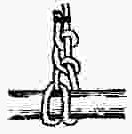 |
| Back Splice -
Also known as Crown Splice and Dog Pointing. A simple and effective
method of finishing the end of a rope in which a Crown Knot is made
with the strands at the end which are then spliced back into the rope.
It is clumsy compared with Whipping but useful in an emergency or if
it is desirous to know by feel when the end of the rope has been
reached. |
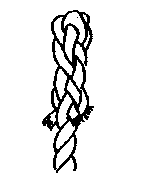 |
| Bale Sling
Hitch - An effective hitch for slinging or hoisting cases,
bales, logs, etc. It cannot jam nor slip and is immediately cast off.
It is the commonest form of Barrel Sling when the barrel must be
hoisted with the bung uppermost. It has the same form as the Lark's
Head Knot. |
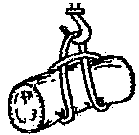 |
| Barrel Hitch
- This is the simplest yet most effective method of slinging or
hoisting a barrel in a vertical position |
 |
Becket - Definition
The eye or hook of a pulley block. A rope handle on a sailors sea chest. An eye
in the end of a rope. There are also certain specialised meanings.
| Becket Hitch
- Any hitch that is made on an eye, etc. (i.e. on a 'becket' is a
Becket Hitch but the Becket Hitch is the one illustrated here. It has
the same form as the Sheet Bend). |
 |
Belay - To
secure a rope with figure-of-eight turns around a belaying pin or a cleat, etc.
Climbers have adopted the term from the sailor: the leader on a climb 'belays'
the following man by passing the rope across his shoulder or waist, taking up
all the slack and paying out or drawin in under friction as the second man
climbs.
| Bellringers
Knot - A method of taking up the slack of a rope when one end
is secured at a height with the rope hanging. So called because it is
a common method used by bellringers to hoist up the bulk of the rope
off the floor and out of the way. It is actually half a Sheepshank. |
 |
Bend - Definition
A knot which is used to tie two ropes together by their ends. As a verb, the act
of tying two ropes together by their ends.
Bight - Definition
1. The portion of a rope between the end and the standing part. 2. Any slack
part of a rope, particularly if in the form of a loop or partial loop.
| Blackwall Hitch
- A simple yet secure method of fastening a rope to a hook: it should
only be used when the thickness of the rope is nearly enough to fill
the mouth of the hook. The Double Blackwall Hitch is a variation in
which a turn is taken round the neck of the hook. |
 |
| Blood Knot - A
multiple Overhand Knot tied in the end of a heaving line. It derives
its name from its use in a ropes end which was used as a weapon or for
inflicting ounishment, when it would often 'draw blood'. This knot was
used by the Incas of Peru in 'Quipus' or knot records. |
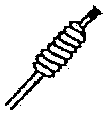 |
| Bowline - The
most useful and one of the simplest ways of putting a fixed loop in
the end of a rope. It is easy to tie and to untie, it never slips nor
jams and has a high breaking strength. It has been called the 'King of
Knots'. |
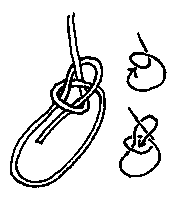 |
| Bowline Bend
- A bend formed from two interlocking Bowlines. Most useful for
joining two ropes of widely different thicknesses. |
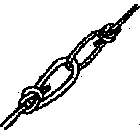 |
| Bowline-on-a-bight
- A double loop knot which is tied in the bight when the two ends are
fixed or inaccessible. The strain should come equally on both standing
parts. A good rescue or chair knot. |
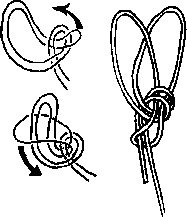 |
| Buntline Hitch
- An excellent and safe knot. Since the second half-hitch is jammed
inside the first it is superior to two half-hitches. |
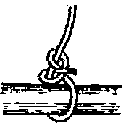 |
Cable or
Cable Laid Rope - Three plain or hawser laid ropes which are righthanded,
laid up together lefthanded, making a nine-strand rope.
Cable Length
- As a unit of measurement, 100 fathoms. As a length of actual cable, usually
120 fathoms.
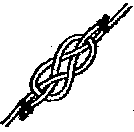 |
Carrick Bend
- An excellent knot, probably the nearest to the perfect bend. It is
symmetrical, easy to tie, will not slip nor ham, is very strong and is
easily untied. Its particular use is as a bend for hawsers and cables.
It can be used in two forms, drawn up or open and seized and it should
always be tied so that the two ends are diagonally opposite. |
 |
Cats Paw - The
most suitable Hook Hitch for slings and probably the best. It cannot
jam and spills immediately when taken from the hook. It is
particularly suitable for heavy lifts. |
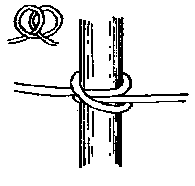 |
Clove Hitch -
The nearest there is to a general utility hitch. It is easy to tie in
a number of different ways and to untie. It has a wide variety of uses
but care should be taken not to misuse it: it is so easy to use it
when a more suitable hitch (e.g. a Rolling Hitch etc.) would serve
better. |
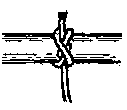 |
Constrictor
Knot - The best and most secure of all binder knots. Provided
that it is tied on a convex surface it cannot slip and grips like a
boa-constrictor, hence its name given it by Ashley who discovered it.
It is, however, often very difficult, and sometimes impossible, to
untie it. |
Cordage - Definition
The general term for all twisted or laid-up rope, irrespective of size or
material.
 |
Crabbers Eye
Knot - Also called the Crossed Running Knot. When tied loosely,
the standing part can be pulled and the knot slid to the required
position: a pull on the end then locks it. |
 |
Cringle - A knot
closely allied to splicing in which a single strand is worked into
another rope, such as the bolt rope of a sail, to provide a loop,
usually to retain a thimble. |
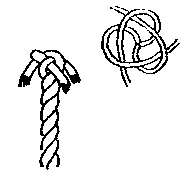 |
Crown - A knot that
is tied in the end of a rope with the unlaid strands. It is seldom, if
ever, used on its own but as a constituent part of a multiple knot,
e.g. a Wall and Crown, etc. It is also used to commence a Back Splice.
The Crown Knot is the exact opposite of the Wall Knot. |
| Diagonal
Lashing - A lashing used for two crossing spars when it is
neccessary first to draw them together. Commonly used for the centre
lashing of the diagonal braces on a Treatle. |
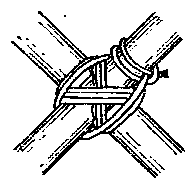 |
| Diamond Knot
- A knot tied with the unlaid strands of a rope to provide a stopper
or a foothold, etc. Also used as a decorative knot, for example, in
lanyards. Can be increased in size and improved in appearance by
'doubling'. |
 |
Dogshank -
Another name for the Sheepshank.
| Double
Blackwall Hitch - This has one more turn than the Blackwall
Hitch and is sometimes recommended as being more secure. It is
doubtful, however, whether this is the case and it would appear that
this is an instance where the simpler form of the knot is to be
preferred. |
 |
Double
Matthew Walker - See under Matthew Walker.
| Double Sheet
Bend - The Sheet Bend is never truly safe and secure when one
rope is thicker than the other. The Double Sheet Bend is a variation
in which an extra turn is taken and, although it is no stronger, it is
more secure. Still another turn can be taken , if thought advisable,
making a Triple Sheet Bend. |
 |
Draw Hitch
- See under Highwaymans Hitch.
End - Definition
The termination of a rope or the free part towards the termination with which a
knot is being tied.
Eye - Definition
A spliced, seized or knotted loop in a rope, usually at the end. It will often
be fitted with a thimble.
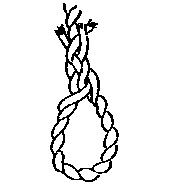 |
Eye Splice - A
method of putting a permanent eye in the end of a rope. The strands
are unlaid, a loop of suitable size formed and the three strands
spliced or worked in and out of the rope, usually under and over.
Three 'tucks' are normally taken. |
Fall - Definition
The rope of a tackle or sometimes the hauling end of a tackle.
| Farmers Loop
- An excellent loop tied in the bight. It has a good lead, is strong
and secure and is tied by an ingenious and easily remembered method.
It is to be preferred to the better known Man Harness Knot. |
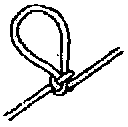 |
| Fid - Definition
A long, tapering cone, usually of hard wood, used to open the strands
in spicing, rounding out eyes, untying reluctant knots, etc. The
rounded end is also used for pounding. |
 |
| Figure-of-Eight
Knot - Sometimes called the Flemish Knot. A single strand
Stopper Knot, usually when only a temporary stopper is required or
when using small stuff. |
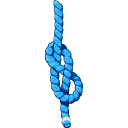 |
| Firemans
Chair Knot - A double loop knot used for lowering an injured
person from a height. It is tied in the bight, one end secured aloft
and the other end used to control the direction of lowering. |
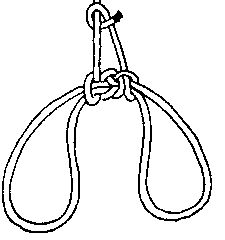 |
| Fishermans Bend -
This is one of just three knots incorrectly called 'bends' which are
actually hitches. It is strong and secure and is probably the most
used Anchor Hitch, apart from being an excellent hitch for all normal
purposes. |
 |
| Fishermans Knot
- Also called Water Knot, Anglers Knot etc. It is formed from two
overhand knots each tied round the opposite end: it is very suitable
for rope in general and is used mainly for small stuff. It is,
however, beginning to find favour amongst climbers as a bend for nylon
rope. |
 |
Flake - Definition.
A turn, or a number of turns in a coil of rope. Falking - Coiling rope in
various ways.
| Footrope Knot
- A stopper knot for the end of a rope. It is similar to the Diamond
Knot but is tied by first making a Crown with the unlaid strands and
then a Wall Knot below the Crown, the ends being brought up through
the centre of the Crown. This knot can be doubled by following through
above the first lead. The name is often applied also to the Standing
Turks Head. |
 |
Frapping -
Definition. Crossing turns taken in a
lashing or on the leads of a tackle to both tighten and secure them.
 |
Granny Knot -
Also called the Lubbers Knot. It resembles a Reef Knot superficially
but it is inferior and should never be used. As the two half knots are
tied in the same direction and not opposite as in the Reef Knot, it
tends either to slip or to jam, or both. |
| Guyline Hitch
- See Midshipmans Hitch. Adjustable Guyline Hitch. Start with two
overhand knots fairly close to each other, rope round peg, back
upwards then DOWN into the two knots. Will adjust by pulling and jams
to your adjustment. Needs no other knot to hold tight! Paul
Calleja-Gera Group Scout Leader 15th Cheltenham (SHURDINGTON) |
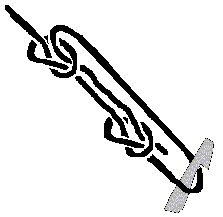 |
|
![[Company Logo Image]](_borders/unitheader.jpg)